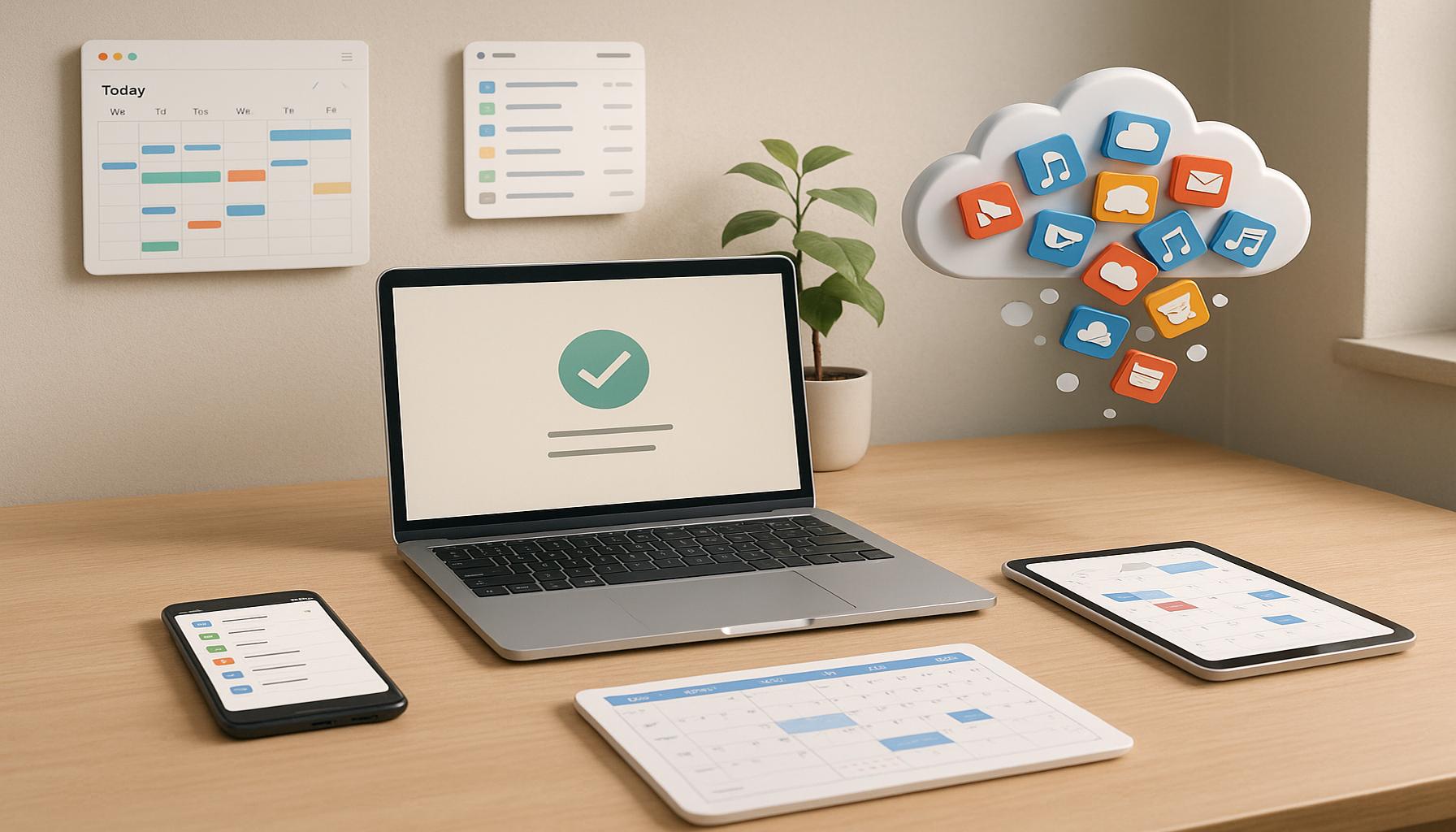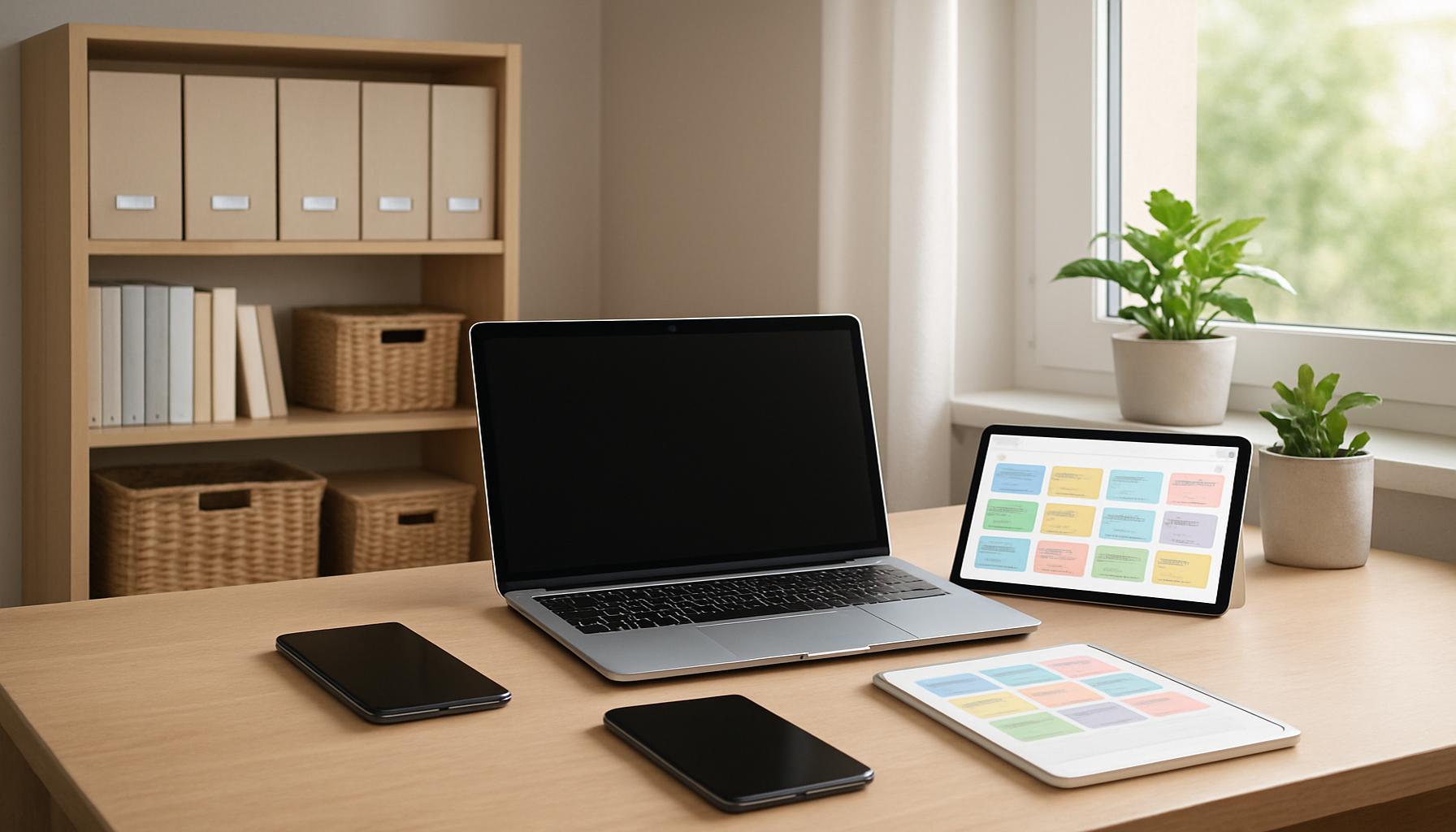Digital Decluttering Boost Productivity by Cleaning Virtual Spaces

Introduction
In today’s fast-paced world, technology is both an indispensable resource and a relentless source of intrusion. With every ping of a notification and every influx of unread emails, our digital spaces can quickly become overwhelming and chaotic. Amidst this digital deluge, the philosophy of Minimalism has emerged as a beacon of simplicity, offering a way to declutter and reclaim our virtual domains.
The essence of digital minimalism lies in simplifying and organizing one’s online interactions and digital environments. It’s not merely about reducing the number of icons on your desktop but also crafting an ecosystem that enhances your productivity and mental well-being. In fact, studies have shown that a tidy workspace can lead to increased focus and creativity, allowing for a more enjoyable and effective working experience.
Throughout this article, we will embark on a journey to explore practical strategies that can help in streamlining your digital presence. Whether your aim is to declutter your never-ending folders of files, manage a tidal wave of emails, or optimize your time spent on countless applications, these techniques will provide structured solutions to bring order to chaos. Discover these top five methods that promise to restore clarity and control over your virtual life.
Top 5 Strategies for Digital Decluttering to Enhance Your Productivity
In today’s fast-paced digital environment, clutter is no longer limited to our physical surroundings. Our virtual spaces, perhaps even more so, are susceptible to the chaos brought on by an influx of emails, apps, and digital files. Just as tidying up a cluttered desk can liberate your mind to focus on the tasks at hand, decluttering your digital environment can have a similarly profound effect on productivity and creativity. This article explores the top five strategies for achieving a streamlined digital workspace, empowering you to manage your digital life with enhanced focus and efficiency.
5. Organize Your Desktop and File System
The computer desktop is often the first thing you see when powering on your device, making it a crucial area for decluttering. A chaotic desktop can consume time as you search for the files you need, leading to distraction and frustration.

One effective approach is to create folders tailored to different aspects of your personal and work life, such as “Work Projects,” “Personal Documents,” and “Financial Records.” Organizing your files into these folders reduces the cognitive load caused by visual chaos. To ensure this system remains efficient, utilize a naming convention that is intuitive, like “Project_Year_Month” for better tracking and retrieval of your files.
Furthermore, it’s vital to regularly assess and delete unnecessary files. Set aside time each month to review these files and get rid of the outdated or duplicate versions. This regular cleansing practice not only maintains order but also optimizes your device’s performance.
4. Unsubscribe and Manage Email Effectively
Email, though essential, can quickly become overwhelming. The deluge of promotional messages, newsletters, and non-essential notifications can clutter your inbox, pulling you away from important messages.
Begin by setting a dedicated time each week to review your subscriptions. Filter out and unsubscribe from emails that offer little to no value. This proactive approach will significantly reduce the volume of incoming emails, allowing you to prioritize what matters most.
Organizing your inbox requires creating categorized folders, such as “Urgent,” “Follow Up,” and “Read Later.” This categorization helps streamline your email management, enabling you to quickly identify and address important communications. Consider leveraging tools like unroll.me that simplify the process of managing subscriptions and decluttering your email landscape.
3. Limit the Use of Applications and Software
The digital marketplace is flooded with applications promising increased productivity and efficiency. While these tools can be beneficial, their abundance can lead to clutter and overwhelm. Conducting a comprehensive audit of the applications on your devices is key to understanding their necessity.
During this audit, ask yourself if each app genuinely enhances your workflow or simply adds to the digital noise. Retain only the essential applications that offer tangible benefits, such as productivity tools, communication platforms, and project management apps.
Additionally, regularly review your app permissions. Remove permissions from and uninstall apps that are no longer used. This practice not only declutters your interface but also protects your digital privacy and security.
2. Utilize Cloud Storage and Organize Files
Embracing cloud storage solutions is transformative for managing digital files. Moving your files to the cloud not only liberates space on your local devices but also ensures access from anywhere with internet connectivity.
Begin by selecting a reliable cloud service that aligns with your storage requirements and usability preferences. Options like Google Drive, Dropbox, or OneDrive offer various features that cater to different user needs.
Once you’ve chosen a service, organize your cloud files systematically. Use a hierarchical file structure that mirrors your existing physical filing system, making navigation intuitive and retrieval efficient. It’s also essential to regularly back up crucial data, storing copies in multiple locations to safeguard against loss.
1. Implement a Digital Decluttering Routine
The cornerstone strategy for managing digital clutter is establishing a consistent routine. Setting aside dedicated time for weekly or monthly digital decluttering ensures that chaos does not accumulate unnoticed.
During these decluttering sessions, review all facets of your digital spaces—emails, file systems, apps, and cloud storage. Prioritize tasks such as clearing junk files, updating file organizational structures, and managing digital subscriptions. Furthermore, consider setting alerts or reminders to prompt periodic evaluations, preventing oversight.
Implementing a structured routine not only revamps your virtual environment but significantly enhances productivity by allowing you to focus on the tasks that truly matter.
In conclusion, digital decluttering is not a one-time task but a continuous commitment to maintaining an efficient virtual workspace. Each strategy outlined here offers a pathway to greater productivity, less stress, and more creativity by minimizing the digital clutter that so easily encroaches on our time and attention. As you adopt these practices, you’ll find that a streamlined digital life can dramatically broaden your bandwidth for other pursuits. May this guide be the catalyst for creating a digital ethos that mirrors the clarity and focus you seek in your physical space.
| Category | Key Features | Advantages | Disadvantages | Who Benefits Most |
|---|---|---|---|---|
| Digital File Organization | Systematic categorization of files and folders | Improved efficiency in locating documents, leading to faster workflow. | Initial time investment in organizing. | Professionals who manage a large number of digital files, such as researchers and project managers. |
| Email Management | Techniques like filtering, archiving, and unsubscribing. | Reduction of email anxiety and clutter, allowing for focused attention on what’s truly important. | Potential for missing important emails during the decluttering process. | Individuals overwhelmed by a high volume of emails. |
| Application Management | Identifying unused applications and removing them. | Improved device performance and reduced distractions from unnecessary notifications. | Risk of removing apps that might be needed occasionally. | Tech-savvy users and multitaskers needing streamlined access. |
| Cloud Storage Solutions | Using platforms like Google Drive or Dropbox for virtual storage. | Accessibility and collaboration are enhanced, allowing easy sharing and retrieval of files. | Reliance on internet access and potential security issues. | Remote workers and teams collaborating on projects across various locations. |
In the context of “Decluttering Digital: Estratégias para Limpar Seu Espaço Virtual e Aumentar a Produtividade,” it’s essential to explore many avenues that contribute to a streamlined digital environment. Each category outlined above is intrinsically linked to increased productivity as they address distinct areas of digital disorganization.The process of digital file organization is particularly noteworthy. By systematically categorizing files and folders, users experience a profound shift in efficiency. This streamlined approach allows for swift access to important documents, significantly enhancing workflow. While the upfront investment of time in organizing may seem daunting, the long-term benefits outweigh the initial effort.Further, email management techniques can dramatically reduce the feeling of being overwhelmed by correspondence. Implementing filters, archiving strategies, and unsubscribing from unnecessary newsletters can alleviate email anxiety. This results in a focused approach to important communications. However, caution is necessary, as critical emails could be overlooked during the decluttering journey.Turning our attention to application management, removing unused apps not only frees up storage but also enhances the performance of devices. Users can enjoy a cleaner interface, leading to fewer distractions. Nonetheless, one must carefully assess whether an app might still serve a purpose in future needs.Lastly, cloud storage solutions revolutionize how we manage digital content. With tools like Google Drive and Dropbox, the ability to access files from anywhere can significantly bolster team collaboration. The trade-off, however, includes a dependence on stable internet connections and the need to safeguard against potential data security threats.Collectively, these strategies are invaluable for anyone aiming to achieve a more organized, efficient, and productive digital landscape. They reflect the importance of addressing not just the physical aspects of clutter but also the mental load that arises from digital chaos, paving the way for improved productivity.
Frequently Asked Questions about Decluttering Digital
What are the benefits of decluttering your digital space?
Decluttering your digital space can lead to several significant benefits. One of the primary advantages is the increase in productivity. By removing unnecessary files, apps, and data, you can reduce distractions and focus better on important tasks. Additionally, a decluttered digital environment can enhance device performance, as it frees up storage space and ensures faster processing speeds. Moreover, this practice can contribute to better data security, as it involves organizing and safeguarding important information more effectively.
How often should I declutter my digital environment?
The frequency of digital decluttering depends on individual usage patterns and needs. However, a general recommendation is to conduct a digital cleanup at least every three to six months. This interval allows you to regularly assess the relevance of stored data and remove outdated items before they accumulate to overwhelming levels. Additionally, setting aside time for a monthly checkpoint can help maintain a consistently organized digital space, preventing the build-up of unnecessary clutter.
What steps can I take to start decluttering my digital life?
Begin your digital decluttering journey by conducting a thorough audit of your files and applications. Start with removing duplicate or outdated files and uninstalling applications that you no longer use. It’s crucial to organize remaining items into clearly labeled folders and sub-folders to streamline future access. Utilize cloud storage solutions for important yet seldom-used files to reduce local storage demand. Additionally, consider setting filters or creating rules to manage incoming emails effectively, reducing the clutter in your inbox.
Can decluttering digital spaces really enhance mental clarity?
Yes, many users report that decluttering their digital environment can extend to mental clarity and reduce stress levels. The connection between a tidy workspace and increased mental focus is well-documented, both in physical and digital realms. Eliminating digital clutter can lead to a more streamlined thought process, as you’re not overwhelmed by navigating through a chaotic virtual environment. This sense of organization often translates into higher cognitive functioning and improved decision-making, fostering an overall sense of well-being.
Are there tools available to assist in digital decluttering?
Several tools are designed to aid in the digital decluttering process. Applications like CCleaner or CleanMyMac can help automate the removal of unnecessary files and optimize system performance. Email management tools such as Unroll.Me can assist in organizing inboxes by unsubscribing from unwanted newsletters and consolidating subscriptions. For file organization, consider using file management apps like Dropbox or Google Drive, which offer intuitive sorting and collaboration features. By leveraging these tools, you can efficiently maintain a clutter-free digital environment.
Conclusion
In the modern era, where our lives are increasingly intertwined with technology, the need to declutter our digital spaces has never been more crucial. This article explored various strategies to streamline your virtual environment, ultimately enhancing productivity and peace of mind. From organizing files to unsubscribing from unnecessary emails, each step paves the way for a more orderly and efficient digital life.
One of the top takeaways is the importance of establishing a routine for regularly reviewing and deleting unused files and apps. Not only does this free up storage space, but it also minimizes distractions. Furthermore, the piece emphasized the necessity of implementing a logical naming convention and folder structure, which simplifies file retrieval and reduces the time spent searching for lost documents.
A vital strategy highlighted involves adopting tools and apps specifically designed for personal organization and task management. These resources not only streamline workflow but also bring a sense of calm to chaotic digital environments. Additionally, the concept of setting boundaries on digital communication to maintain focus and prevent burnout was discussed in-depth.
Ultimately, the premise of digital decluttering aligns closely with principles of minimalism and personal organization. By reducing digital clutter, individuals are able to foster a more focused and intentional digital presence. This harmonious approach leads to increased productivity, better mental clarity, and a deeper appreciation for technology as a tool rather than a burden.
As we continue to live in a rapidly evolving digital world, it’s essential to prioritize the organization of our virtual spaces. By doing so, we not only improve our work efficiency but also enhance our overall quality of life.


